
Meeeerrroooowwww. A pained howl erupts out of Chicago tattoo artist Stephanie Brown’s “very rude” cat from time to time, interrupting us as we chat in her comfortable home studio in Logan Square.
As we sip hot tea on one of the city’s first chilly weekends, I get to look around at Stephanie’s space. Objects that vaguely resemble artifacts from some untouched corner of the world reflect and complement Stephanie’s sketches, drawings, and paintings, reminding me how much Stephanie loved drawing at the Field Museum when we met years ago.
Now, Stephanie’s drawings of birds, flowers, bats, bugs, and much more are no longer confined to two dimensions—they live eternally on the skin of her clients. In just four years, Stephanie has become an incredibly successful tattoo artist, achieving creative autonomy at an unprecedented pace in a world that places heavy emphasis on seniority and experience by making some of the most beautiful tattoos I have ever seen.
But it is not just her incredible skill, hard work, and perhaps some luck that have gotten her to where she is now, working at an appointment-only studio in Chicago. As we talk, it becomes clear that Stephanie has grown into a totally badass babe by developing a tough skin and greater confidence in her work, continually pushing herself to be better than what she just did, while also confronting, working around, and listening to her health needs. Even when those needs put her in the ICU earlier this year and temporarily put everything on pause. Oh, and she rides bikes and is starting a side project painting ladies’ motorcycle helmets with her custom designs, which I think we can all agree gives her at least 500 BABE points and a thousand Wayne’s World sha-wings!
Read on to learn more about how Stephanie lives the art dream yet still pushes herself to do more, how she copes with Crohn’s disease, and how she went from drawing on her arm with permanent markers to being the tattooing babe she is today.

You’ve accomplished so much in such a short amount of time! When did you start tattooing, and how did you get to where you are now?
I’ve only been tattooing for four or five years, depending on how you count it, because an apprenticeship is this weird, fluid period before you are given full permission to tattoo. It was ingrained in me when I was coming up that how many years you’ve been tattooing is more important than anything. I was even told to lie to clients at first. People in the shop told me to say I’d been tattooing for at least two years when, really, I’d been tattooing for six months. I was terrified! Like, “Yeah…uh, two years!” [Laughs]
But the way that I work now versus working for a street shop…it’s like two different worlds. In a street shop, you do your walk-ins. You don’t really know what you’re going to get or who’s going to walk through the door. We didn’t have flash at the shop I worked at, so I was still encouraged to draw everything. But I had to work on the fly and hustle people out the door to get the next person in. I spent three years doing that and burnt myself out creatively and mentally.
Then I got the opportunity to work at Butterfat Studios, a shop that’s appointment-only, with just one other person, where I can choose the projects. To have that in four years is totally unheard of. Like, completely unheard of. [Laughs] When I quit the other job in the street shop, people said things like, “I don’t understand. How are you going to get clients? There’s no way this is going to work. How are you going to be busy?” I was honestly not worried about it. I thought, “If I have to starve for a bit in order to do this, that’s fine.” I knew in the long run that getting to a point where I was more directed by myself and my artwork was my goal. But I never thought it would end up happening so soon.
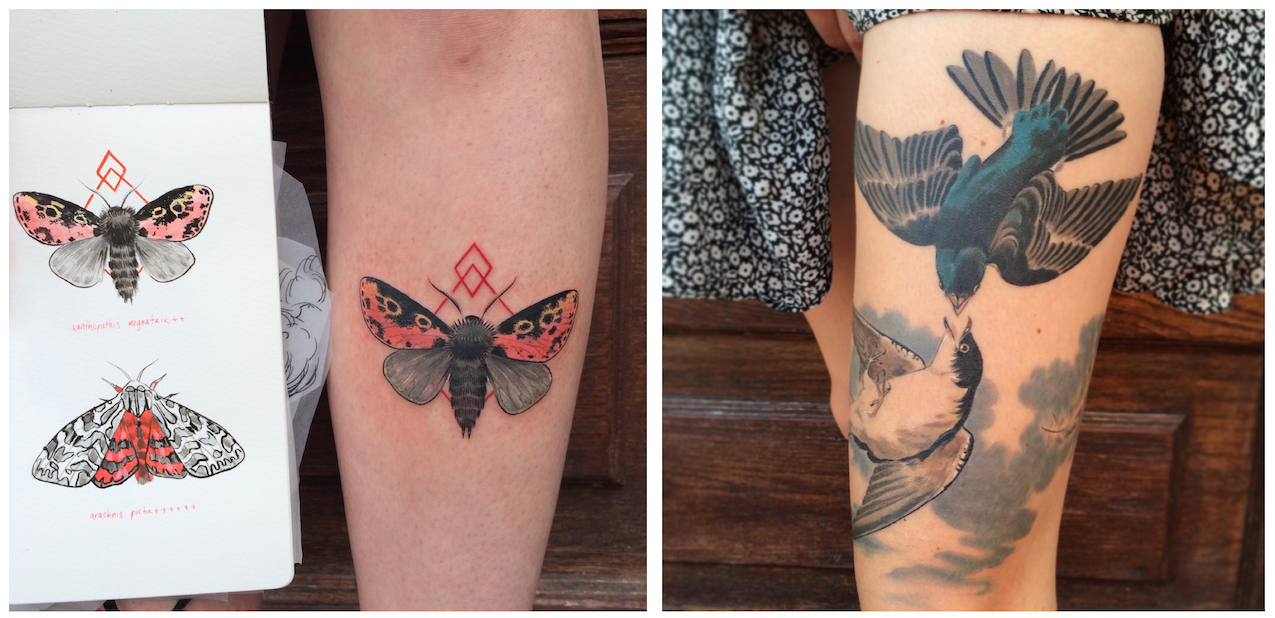
What made it happen so quickly? Was it meeting the person who runs Butterfat, or the way people reacted to your work…or your own ballsiness?
Every time people ask me that, I always say, “I just got lucky.” But I actually did work really hard. In the environment I was in while apprenticing, and being a young lady in tattooing, I had to get tough skin. I learned that the way to keep people off my back when I first started out was to stay busy. And it wasn’t hard. People saw my drawing skill, which has given me such a great step up in tattooing. They would come in and look at my books, and I wasn’t really doing anything like people in the shop or around. It started snowballing through word of mouth. I got pretty busy pretty quickly. That worked hugely to my advantage of getting people who were discounting what I was doing because of my lack of experience to leave me alone in the shop.
I ended up meeting Esther Garcia, my current co-worker, through a friend who was getting tattooed by her. I went to the opening of Butterfat Studios about three years. I saw it, and I was like, “Fuck. This bitch figured it out. She’s got everything.” It was like she took whatever small thing I could have imagined for myself and fully realized it. I thought it was so cool. Some of the people I went with from my shop didn’t seem to respond to it the same way. I was so energized by it. I made a note in my brain: “I will be here someday.” Either by creating something of my own or by working with Esther.
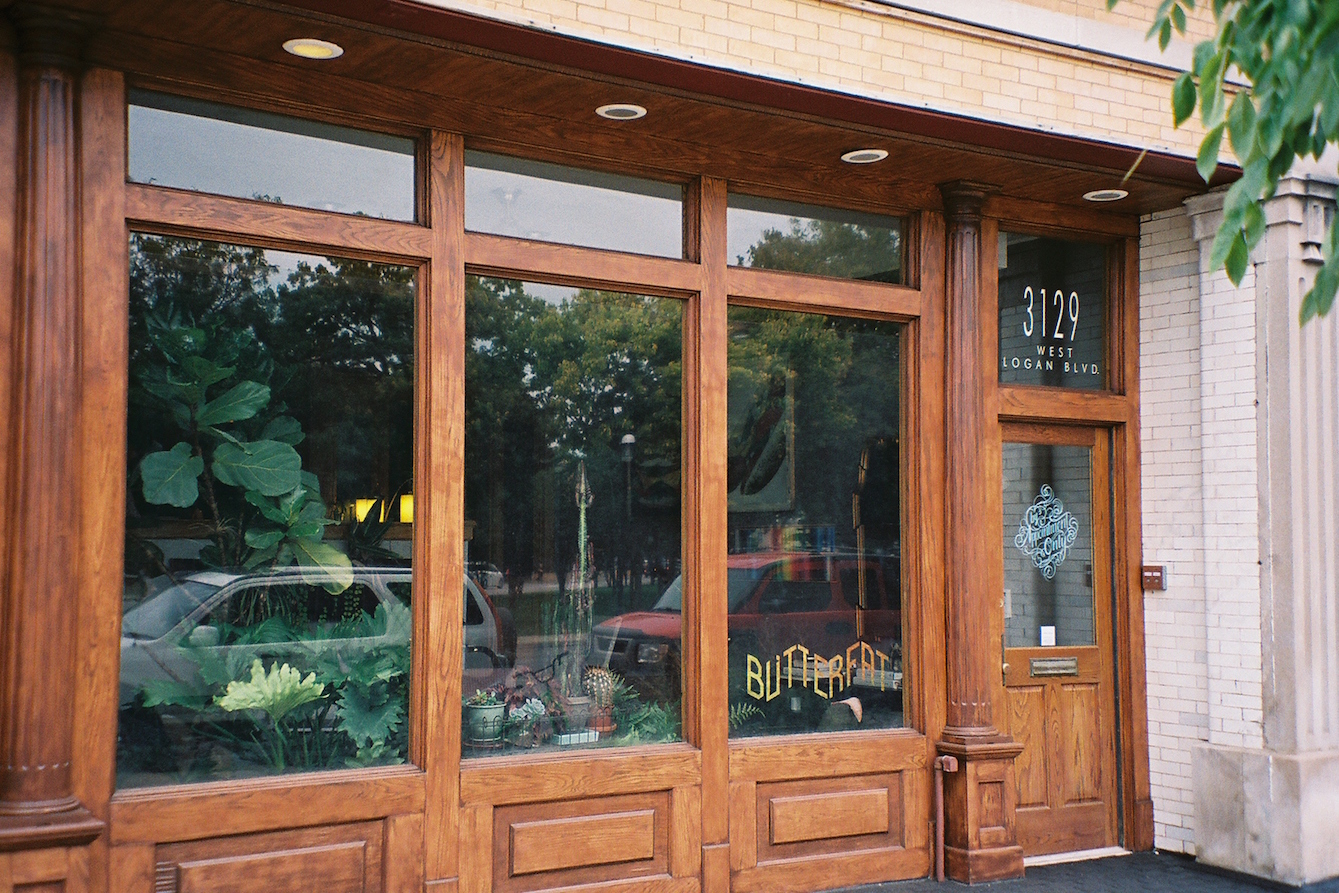
What attracted you to Butterfat? How did you get the job there?
I wasn’t happy where I was, needless to say. I knew I had to put my time in there to get the skills that I needed, but it wasn’t a forever home. When I found Butterfat, I had been snooping around to figure out where I could be in Chicago, or if I needed to move.
When I met Esther, she was one of the few people in tattooing that I had ever met who was open and helpful, not competitive. A lot of the language that the people I was working with in the street shop used was very unsupportive and competitive. Like, if someone did something really awesome, they were like, “Fuck that guy. I’m going to break his arms.” I didn’t notice it at first, but once I started realizing the way people were dealing with that it seemed so unhealthy and jealous—like that kind of weird competition that’s not going to help you grow at all.
When Esther first opened her shop, it was just her and an apprentice, and then her apprentice moved to California. I knew Esther well by then. We had hung out a few times and were friendly. When she posted online looking for a new artist, I figured that she had to have thought of me. I called and made it clear that I wanted to work with her. The ad said that I needed five years of experience, and I only had three. I told her I knew I didn’t have the experience she was looking for but thought that our work would complement each other. She said, “Yeah, I thought about it, but no.” She rejected me.
This is where luck comes in: anybody else who applied just wasn’t fitting what she wanted. I was actually getting tattooed at Butterfat by a guest artist, and Esther asked me to work there. I was in the middle of a four- or five-hour tattoo. I was like, “Can you just say that again in another hour? Can we revisit this?” [Laughs]
How does working in an appointment-only studio change the work you’re able to do?
Working in a private studio has given me so much freedom from the drama and the sense of quantity-over-quality that comes with working in a street shop. When I made the move to Butterfat, it was less about making money—which I didn’t even think about—and more about the work that I would be able to do.
The type of work I do now requires a lot more legwork and work on my end. I often design and conceptualize a tattoo fully before even presenting it to the person. I’d much rather take my time with something, and I can all the time I need now. The way I see it, with the time I put into it, the environment that you’re getting tattooed in at Butterfat, and the kind of tattoo you’re going to get, it’s not comparable in any way to a street shop. At least to any in Chicago, if not wider than that.
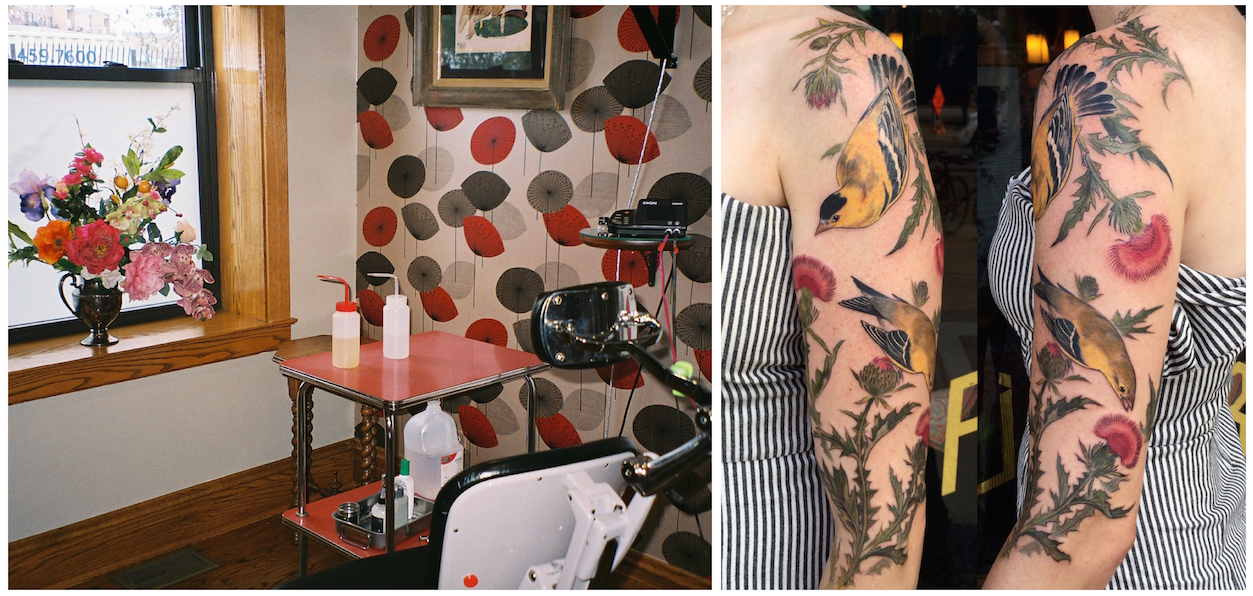
We don’t have many Yelp reviews, and I don’t count them for much, but there’s one guy who said that patience is rewarded highly at our studio, and that’s very true. A lot of the work we do is not something that will get done in one session. Butterfat is an environment where I can do that kind of work, and my clients have been so incredibly gracious and trusting in me and the process. They allow it to become this really beautiful final piece when, in the middle, it might not seem like that because we’re doing color washes or layering stuff. We’re not slapping something on and getting it done in a couple of hours. It’s completely different.
When I met you, you were primarily focused on painting and drawing. What brought tattooing into the picture? Was it already in the back of your mind?
I’ve always been interested in tattoos, even when I was a lot younger. I would draw on myself in school when I was, like, 15, and people would ask me if it was a real tattoo. I thought I was so boss for someone to be asking me that. [Laughs] I remember trying to go into a tattoo shop—I wish I could remember the name of the shop in San Diego—but I was 15, and they were like, “You can’t be in here!” This one guy there was so nice to me. He showed me through his books and treated me like an adult, which was nice, and not like an idiot kid poking around.
I tried to get a desk job at a tattoo shop when I was 18 in Arizona. In hindsight, I’m so glad I didn’t get it. But I did all the research I could. I read so much about it. I bought a tattoo machine on eBay when I was 19 and read a book about the mechanics of it. I ended up tattooing a bunch of my roommates and myself in the living room. Then I got the opportunity to move to Chicago and go to School of the Art Institute of Chicago (SAIC), and I just sort of picked up everything and left. I actually came to SAIC thinking I would do illustration, but there isn’t even an illustration program there. [Laughs]
There, I kind of drank the Kool-Aid, so to speak, of conceptual art and the gallery world. Which is not to say I’m not interested in those things. I’m very interested in those things. But I ended up meeting a now-friend in one of my painting classes there. She was painting but also tattooing full-time. I bugged the shit out of her, asking so many questions. She asked me if I had ever thought about doing it, and it was like remembering this thing in my brain that had totally been dormant for a really long time. I had completely forgotten about it. Ultimately, she helped me get the opportunity to start the apprenticeship.
It’s just so funny because I don’t think it would have even entered back into my mind at that point. My plan after college was just to get a serving job and paint, and see what happens. [Laughs]
How do you bring your fine art background to your tattoo work?
Working in a street shop, when you have people giving you their ideas, it allows you to detach from the thought behind it because it’s not necessarily your responsibility. They just tell you what they want. Now, doing my own projects, there’s a lot more responsibility and integrity on my part. I put a lot of pressure on myself to make them good. People put a lot of trust in me, too, and I never want to lose sight of that because it’s such a huge gift—that people put their skin in my hands, literally.

You do still draw and paint, too. How do you balance your tattooing and other creative practices?
Yeah, there’s something that comes with making your hobby—something that you do for your own benefit and pleasure—your job. The pleasure I used to get from my artwork also comes from my work-work—I get paid for it now. Which means there’s no separation between my days off and my days at work. It’s a constant engine going in your head.
I think it’s important to keep something sacred to you in your art, and there are ways to do that, but it’s also really easy to lose sight of that. Being able to fully enjoy drawing the way I used to—in a safe place where it doesn’t have to be shown—is actually much harder for me now. I’ve been trying to paint more with less consequence, not worrying about having it fit into a print or tattoo in my head.
I’ve been trying to paint more. Painting helps completely undo all of the tensions that tattooing builds up. In tattooing, all of your wrist movements are so minute, while you can use more of your full arm and there’s more fluidity painting. I’m trying to do it for myself, which is hard.
How do you keep from getting burnt out?
I get burnt out all the time! It’s, like, weekly. When it comes to being burnt out, not just mentally but physically, I got to experience that 100% this year. I was in the hospital for ten days, and the ICU for seven of those days.
Oh no! Why were you in the hospital for so long?
My health has always been an issue, and it’s one of those things that undermines everything. I have Crohn’s disease. It’s vey unpredictable and not particularly well-managed. I’m still in the process of trying to figure out what medication or lifestyle works.
When I got sick in January, I had been used to being sick for awhile. It’s shocking what you can get used to. The whole end of last year, I was super-tired and had been cancelling a lot of appointments. I thought it was just my typical Crohn’s disease stuff—it really drains you of everything. I had been blacking out while I was walking around. I slept for fourteen hours once and woke up, like, “What’s wrong?” That’s not normal. Eventually, I ended up going to the hospital. I almost didn’t because I had been to the hospital without insurance before and had such a bad experience.
I got to the hospital, and I was talking to them really nonchalantly, like, “Oh, I just have Crohn’s disease. I’m probably just dehydrated. I haven’t been able to keep food down.” But while I was talking to them, apparently I was just, like, no color [passes her hand over her face], completely blue. It turns out I was in full kidney failure, and I had all of these blood clots in my kidneys that were basically shredding my blood. The nurses said that if I had not gone to the hospital, I would have had either a heart attack or fallen into a coma.
And it wasn’t from the Crohn’s disease. It was this very rare blood disease. I can’t afford the test to tell me that it’s not this other incredibly rare, worse version, which I still may have.

While I was at the hospital, I went through all these tests. I got blood transfusions. I got plasma transfusions. I basically got a full oil change of blood and plasma. Then, I almost got discharged from the hospital. I was about to go out the door. I could smell the fresh air. Then I started seeing colors, and I couldn’t breathe, and I ended up having a bunch of fluid in my lungs and pneumonia. I was put right back in the hospital. It was crazy. It was literally a life-and-death situation in the most serious way. I needed help walking around the ward. I couldn’t walk on my own. I couldn’t do anything on my own. They put this giant tube—I still have a scar from it here—into the artery in my neck that feeds a tube into your heart. That’s where they would hook up this transfusion machine.
That was less than a year ago, and I was back to work a month after that. That is so overwhelming to think about right now. The worst part of all of that is that I’m still dealing with the insurance and the unbelievable amount of paperwork from that. It’s exhausting, and very expensive to stay in the ICU that long.
I’m fine now, apparently. I’m going to keep on trucking, but…it’s one of those things that is definitely always in the back of my mind. To have that kind of experience and be left with these questions that the doctors don’t even really know the answers to…you keep on living your life and hope you’re not a ticking time bomb.
Wow, Stephanie. That all sounds so terrifying. How are you coping now? How did you start back at work only a month after that?
Coming back to work was a struggle. I had a lot of recovery to do. I still struggle because of that. I haven’t been at 100% for a long time. Tattooing is a really physical sort of process that makes it hard to do if you’re feeling any kind of discomfort. I’ve had to really know when to say no and not feel guilty. There was a lot of guilt involved in canceling on clients because I was sick. I never wanted people to feel like I was just hungover or something. Like, there’s nothing cute or funny about this.
I try not to think about it in terms of what it would be like if I was completely healthy. I look at other peoples’ work and sometimes it seems like they can do it all, and maybe I just can’t because I have to not get burnt out or stressed out. It’s great to be able to work the way I work now because I can take on as much work as I want. I don’t have to keep up a quota. I can keep my schedule to something manageable and, even though it’s kind of unpredictable, try to adjust it when I’m not feeling well.
That’s also why painting has become more important to me now. I can be home and do it at my own speed. I can be in my home studio and be resting, technically, but getting something done. I felt so guilty about not being in the shop working when I needed to be at home. Like, doctor’s orders needed be at home. It’s been a huge learning curve to have to deal with all of this on top of trying to figure out how to practically run a business and also be a fully functioning human being.
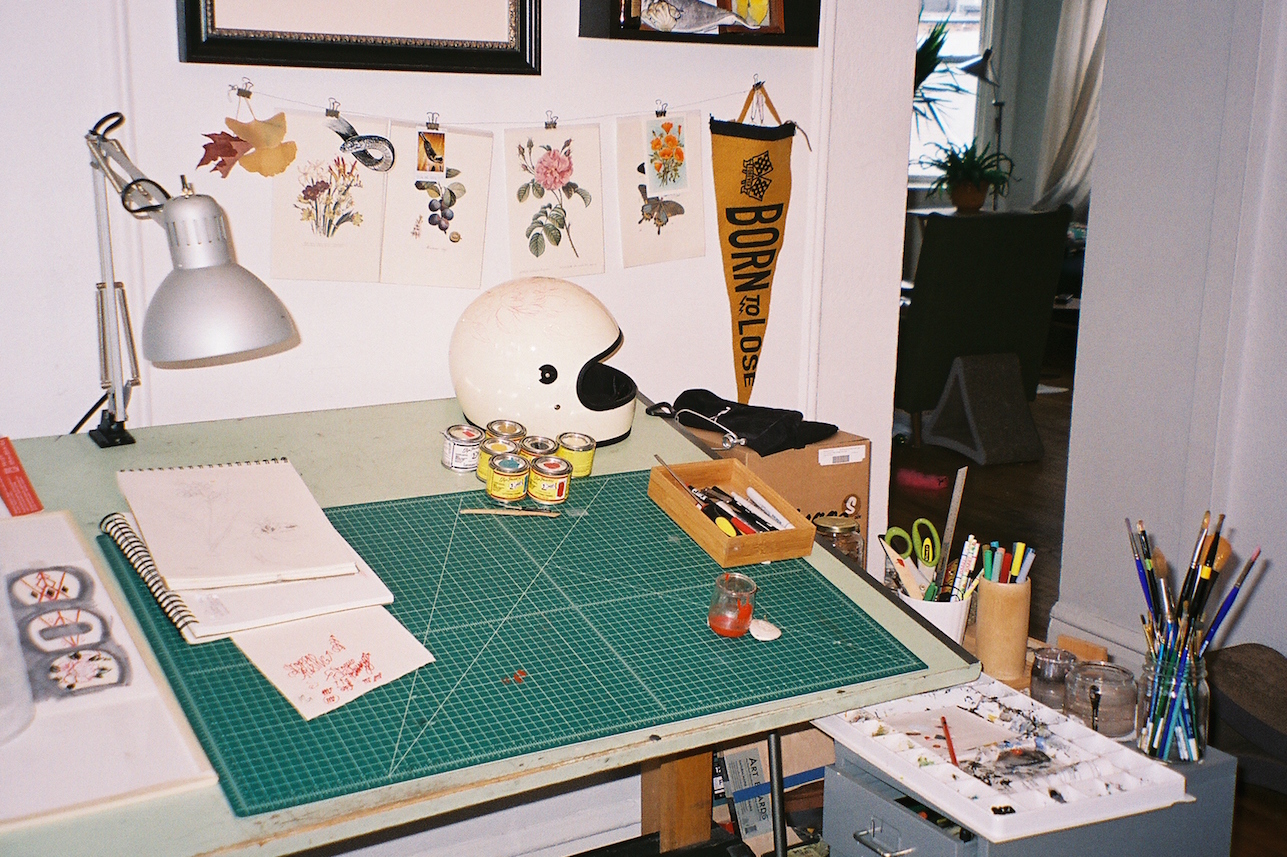
I ask all of our babes if there was ever a moment where you thought it wouldn’t work out. It sounds like there were some very real and scary moments for you. But beyond what we’ve talked about, are there other moments where you had that intense self-doubt and got over it?
Like, all the time. I have a lot more self-esteem about my work now, but I’m never, like, “This is it. I’ve figured it out.” Getting into tattooing, too, there’s so much discouragement from all angles—it’s sort of their job to beat you down. There were times when I thought I was going to quit because I was so broke and so expended—working so much, not getting paid, and just getting jerked around and jumping through hoops.
I think one of my stronger attributes is that I’m incredibly stubborn. If someone tells me no, I’m like, “Well, I’m going to show you.” Like, “How dare you tell me no?” That sort of spiteful motivator has been incredibly powerful in my life, especially more in the past. Now, it’s about finding something that I find fulfilling and interesting to do.
But yeah, I am my worst discourager. I have definitely had my detractors around me, but it’s always just a constant battle with myself of finding good work to do, feeling that my work is good and worthwhile, and trying to keep it flowing in a way where it’s not relying on one trick or one kind of imagery. I don’t like to repeat myself. I want to keep myself on my toes.

Do you consider yourself successful? How do you ultimately define success?
I think about this all the time. I am truly in the .1% of artists who are working without a side job, basically drawing full-time for a living and having almost entire creative freedom. I’m under 30. I’m living the artist dream. It’s still very hand-to-mouth, but I draw for a living. That’s incredible.
But it goes back to that making your hobby your job thing. The bars of success become so much higher each time you reach something that you think is what you want. Suddenly there’s another step to achieve. That’s healthy in a certain way. It’s also just part of of my personality and the expectations I have for myself. But it’s impossible and unsustainable. Once you get to your next goal, then what?
I’ve been thinking about that a lot—that what I define as success isn’t what anybody else is going to say it is. Personal and emotional fulfillment in my creative work…I guess that’s what I want. I do not know what that looks like. I don’t know if that involves me being, like, a fully-formed, happy person where I’m happy in my work and happy in my life…[Laughs] I just don’t think that’s possible. I don’t ever see it being an endpoint.
Constantly turning things over in my brain and second guessing myself…I don’t think that’s ever going to stop. I just need to get to a point where I can accept it and…just congratulate myself once. [Laughs] If I finish something, I’m always just like, “Okay, that was good. Let’s move on.”
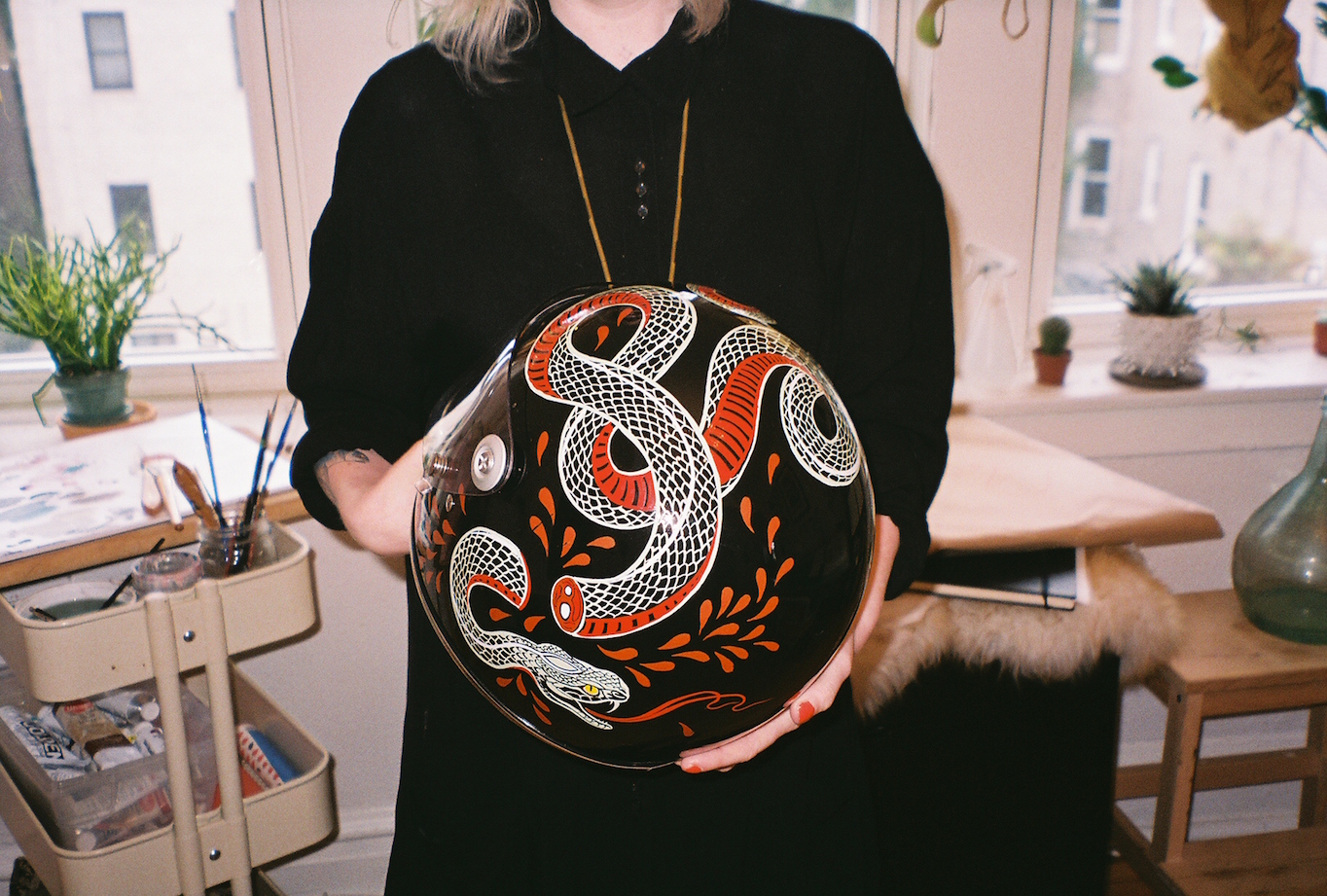
What’s next for you? Is there anything on the horizon that you’re excited about?
I’m going on a motorcycle trip this month. I’ve been planning it for a long time, and I’ve been riding bikes on-and-off for a long time. I finally bought a motorcycle. I have friends who ride back in Phoenix, where I grew up. I’m going to fly back there, and then we’re going to ride and camp around California, go to this women-only motorcycle campout called Babes Ride Out in Joshua Tree, and then go up north for a bit. I’ll be gone for two weeks. I’m super-excited about that. Riding bikes requires complete focus, and everything else just goes away. I love it so much. It’s completely therapeutic. I get such a thrill out of it that nothing else is in my brain. That’s so nice.
Stephanie can be found at Butterfat Studios in Chicago and will also be returning to Wonderland Tattoo in Portland, Oregon later this year to participate in a benefit for the Audubon Society. Follow Stephanie on Instagram to keep up with her new work, and check her website for available tattoo projects and more artwork. You can also watch Stephanie’s Creative Mornings talk to see her in action!


No Comments